Today, we’re going to finalize our examination of cotton embroidery threads, insofar as they relate to the Secret Garden embroidery project. I’m sure there are many, many angles from which we could examine many, many more types of cotton embroidery threads, but for now, we’ll finish with the choices for this particular project.
Previously, we examined both floche and coton a broder side-by-side and looked at their size and construction. We then lined them up, unstitched, against the more familiar perle cotton in various sizes and regular 6-stranded cotton embroidery floss. Then we looked at perle cotton and stranded floss, stitched. And now it’s time for floche and coton a broder, side-by-side, stitched.
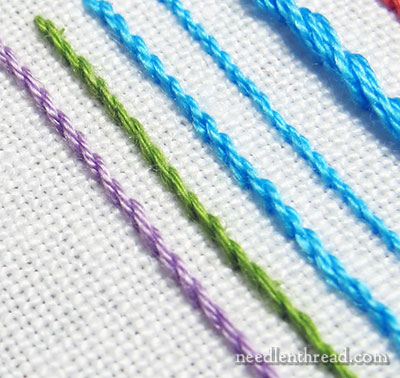
The stem stitched lines we’ll be concentrating on first are the green and purple lines in the photo above. Can you see any differences between the two lines (aside from the color)? Can you tell which thread is which?
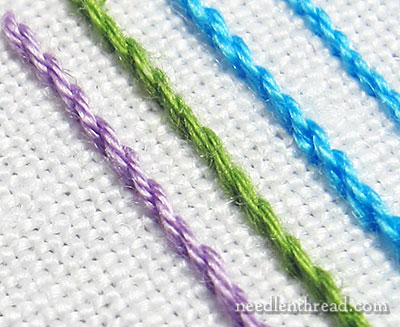
Zooming in a little closer, notice that the purple thread has a little more definition to it. The twists that actually make up the thread (not the twists in the stitch) are a little more defined.
The green thread has much longer looking twists to the thread. It isn’t reflecting the light the same way, even though it is also a mercerized thread, like the purple thread.
You might be tempted to think that the purple thread is made up of more plies of thread twisted together, and that this is why the thread has a more distinctive ropey look to it. But in fact, the purple thread is the coton a broder, and it is made up of only four plies twisted together.
The green thread is floche, and it is made up of five plies, which are much finer, and little looser in their twist in the construction of the thread.
The stem stitch on both lines is the same size. But notice how the floche seems to draw out into a longer, straighter stitch, compared to the coton a broder. Each stitch is not as defined.
Although the two threads are similar in size, they do have a different look to them, and they perform a little differently, too. Coton a broder is the more sturdy of the two threads. Floche is more delicate and is softer.
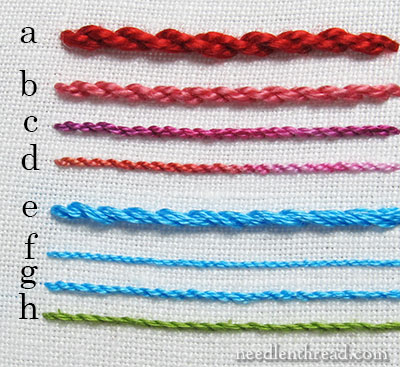
Here are the perle cottons (on top, a-d), the cotton floss (e-g), and the floche all lined up, so that you can see the size comparisons.
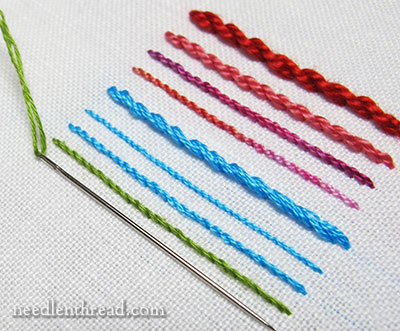
Since a couple of you asked about including a needle in the photo to give a sense of size reference, here you go! That’s a #7 crewel needle.
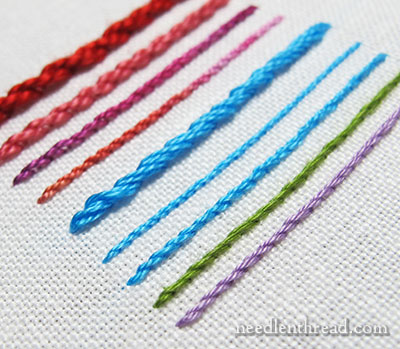
Unfortunately, I didn’t get a straight-on shot of all the threads, with the coton a broder included, but you can still get an idea of the sizes of all the threads here.
The finest is one strand of regular cotton floss. Next up, the floche, followed closely by coton a broder, and then two strands of regular floss, which is followed closely by perle cotton #12.
The threads that I’m interested in using for my version of the Secret Garden 101 project are regular cotton floss, floche, or coton a broder. Perle cotton #12 could work for stems and the like, but I believe it would prove too heavy for some of the detail work, and combining the types of threads could detract from the coherency of this type of embroidery. On the other hand, if you like the texture, you can always play with a combination.
I spent some serious time pouring over threads, considering pros and cons of the different types, looking at color options, and stitching some small sample areas like this one. My conclusion? Well, I think I’ll have to show you in pictures. I haven’t solidified everything absolutely just yet, but I’m pretty certain which thread I’ll be using.
Want to take a guess? Feel free! I wonder if you’ll be surprised?







I am guessing regular old DMC cotton floss. Why? Because you said we would be surprised and I just assumed you would be using something more fancy…
I will guess floss also. I bought some floche to use though as it will be a new thread for me.
Since we’re just making guesses, I’m going to vote for the five ply floche for the outlines…it’s super clean look and smooth line is appealing and and this is a very ‘line heavy’ design – or is it? You’ve done the thread comparisons in stem stitch, but are you going to be doing lines in the Garden? If you’re going to go with a needle painted approach to color blocks and not with outlines?…well, maybe the DMC singles? If you’re doing ‘something else’, then heaven only knows…maybe ALL OF THEM will get used somewhere or other!
I didn’t think that the lines of stitching were only as long as the needle! I am not usually good at guessing, but I will guess perle cottons.
Thanks! Sarah 🙂
I’m guessing cotton floss so that you could use various numbers of plies in different parts of the design.
Dear Mary
The comparisons of the different threads of peele cotton, DMC floss, Coton a border and Floche is very interesting and informative. My guess is that you will use floss because it’s more versatile as you can split the strands for a thinner look or add more strands for a thicker look. Plus it has a sheen which would enhance the design. Thanks so much for the photos and sharing with us the differences between cotton threads you always inspire me with your thread talk, thanks.
Regards Anita Simmance
Hi Mary,
I am guessing the cotton floss, because after rendering the pattern three times (once w/pencil from the book, once going over the pencil w/ink, and once on fabric by tracing over the inked pattern) I have found there are some teeny-tiny spaces in it that will need just a smidge of color to make it look lovely.
I really appreciate these tutorials on thread. It seems that “some” embroiders know all about this but others, like myself do not. I am embroidering script sayings for a quilt I am making and after reading your article I settled on #5 Pearl Cotton.
It would not have entered my mind to use this type of thread. Thank you and please keep up the tutorials on the “little” things that are the most important.
Before I eve look at other comments I’m guessing the coton a broder?
I think either stranded DMC, or Coton a Broder. The advantage of stranded floss, of course, is that all the colors are readily available, and inexpensive. Mixing the two is what I’m unsure of. I don’t have any Floche, and probably won’t buy any. But I believe the ones I mentioned mix mix ok.
Can you do a comparison of size between all 3 types: DMC 6 strand, perle, and coton a broder?